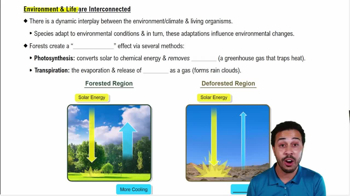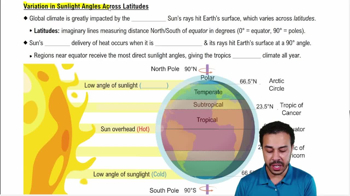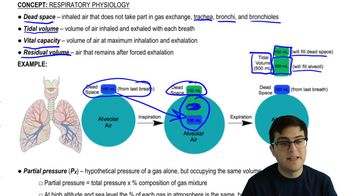Table of contents
- 1. Introduction to Biology2h 40m
- 2. Chemistry3h 40m
- 3. Water1h 26m
- 4. Biomolecules2h 23m
- 5. Cell Components2h 26m
- 6. The Membrane2h 31m
- 7. Energy and Metabolism2h 0m
- 8. Respiration2h 40m
- 9. Photosynthesis2h 49m
- 10. Cell Signaling59m
- 11. Cell Division2h 47m
- 12. Meiosis2h 0m
- 13. Mendelian Genetics4h 41m
- Introduction to Mendel's Experiments7m
- Genotype vs. Phenotype17m
- Punnett Squares13m
- Mendel's Experiments26m
- Mendel's Laws18m
- Monohybrid Crosses16m
- Test Crosses14m
- Dihybrid Crosses20m
- Punnett Square Probability26m
- Incomplete Dominance vs. Codominance20m
- Epistasis7m
- Non-Mendelian Genetics12m
- Pedigrees6m
- Autosomal Inheritance21m
- Sex-Linked Inheritance43m
- X-Inactivation9m
- 14. DNA Synthesis2h 27m
- 15. Gene Expression3h 20m
- 16. Regulation of Expression3h 31m
- Introduction to Regulation of Gene Expression13m
- Prokaryotic Gene Regulation via Operons27m
- The Lac Operon21m
- Glucose's Impact on Lac Operon25m
- The Trp Operon20m
- Review of the Lac Operon & Trp Operon11m
- Introduction to Eukaryotic Gene Regulation9m
- Eukaryotic Chromatin Modifications16m
- Eukaryotic Transcriptional Control22m
- Eukaryotic Post-Transcriptional Regulation28m
- Eukaryotic Post-Translational Regulation13m
- 17. Viruses37m
- 18. Biotechnology2h 58m
- 19. Genomics17m
- 20. Development1h 5m
- 21. Evolution3h 1m
- 22. Evolution of Populations3h 52m
- 23. Speciation1h 37m
- 24. History of Life on Earth2h 6m
- 25. Phylogeny2h 31m
- 26. Prokaryotes4h 59m
- 27. Protists1h 12m
- 28. Plants1h 22m
- 29. Fungi36m
- 30. Overview of Animals34m
- 31. Invertebrates1h 2m
- 32. Vertebrates50m
- 33. Plant Anatomy1h 3m
- 34. Vascular Plant Transport2m
- 35. Soil37m
- 36. Plant Reproduction47m
- 37. Plant Sensation and Response1h 9m
- 38. Animal Form and Function1h 19m
- 39. Digestive System10m
- 40. Circulatory System1h 57m
- 41. Immune System1h 12m
- 42. Osmoregulation and Excretion50m
- 43. Endocrine System4m
- 44. Animal Reproduction2m
- 45. Nervous System55m
- 46. Sensory Systems46m
- 47. Muscle Systems23m
- 48. Ecology3h 11m
- Introduction to Ecology20m
- Biogeography14m
- Earth's Climate Patterns50m
- Introduction to Terrestrial Biomes10m
- Terrestrial Biomes: Near Equator13m
- Terrestrial Biomes: Temperate Regions10m
- Terrestrial Biomes: Northern Regions15m
- Introduction to Aquatic Biomes27m
- Freshwater Aquatic Biomes14m
- Marine Aquatic Biomes13m
- 49. Animal Behavior28m
- 50. Population Ecology3h 41m
- Introduction to Population Ecology28m
- Population Sampling Methods23m
- Life History12m
- Population Demography17m
- Factors Limiting Population Growth14m
- Introduction to Population Growth Models22m
- Linear Population Growth6m
- Exponential Population Growth29m
- Logistic Population Growth32m
- r/K Selection10m
- The Human Population22m
- 51. Community Ecology2h 46m
- Introduction to Community Ecology2m
- Introduction to Community Interactions9m
- Community Interactions: Competition (-/-)38m
- Community Interactions: Exploitation (+/-)23m
- Community Interactions: Mutualism (+/+) & Commensalism (+/0)9m
- Community Structure35m
- Community Dynamics26m
- Geographic Impact on Communities21m
- 52. Ecosystems2h 36m
- 53. Conservation Biology24m
48. Ecology
Introduction to Ecology
Problem 4a
Textbook Question
Areas of low solar irradiation are . a. closer to the equator than to the poles; b. closer to the poles than the equator; c. at high altitudes; d. close to large bodies of water; e. more than one of the above is correct
 Verified step by step guidance
Verified step by step guidance1
Identify the relationship between solar irradiation and geographic location. Solar irradiation refers to the amount of sunlight received by a particular area.
Understand that solar irradiation is generally higher near the equator due to the direct angle of sunlight and decreases as you move towards the poles where the angle of sunlight is more oblique.
Consider the impact of altitude on solar irradiation. Higher altitudes can receive more solar radiation due to thinner atmosphere, but this is not the primary factor in global patterns of solar irradiation.
Evaluate the influence of large bodies of water on solar irradiation. While bodies of water can affect local climates, they do not directly influence the amount of solar irradiation an area receives.
Choose the option that correctly identifies areas of low solar irradiation based on the relationship between latitude (distance from the equator) and solar irradiation.
Recommended similar problem, with video answer:
 Verified Solution
Verified SolutionThis video solution was recommended by our tutors as helpful for the problem above
Video duration:
2mPlay a video:
Was this helpful?
Key Concepts
Here are the essential concepts you must grasp in order to answer the question correctly.
Solar Irradiation
Solar irradiation refers to the power per unit area received from the Sun in the form of electromagnetic radiation. It varies across the Earth due to factors such as latitude, season, and atmospheric conditions. Areas closer to the equator generally receive more direct sunlight, resulting in higher solar irradiation, while polar regions receive sunlight at a lower angle, leading to reduced solar energy.
Recommended video:
Guided course

Environment & Life are Interconnected
Latitude and Climate
Latitude is a geographic coordinate that specifies the north-south position of a point on the Earth's surface. It significantly influences climate and solar energy distribution, with equatorial regions experiencing warmer temperatures and more consistent solar irradiation compared to polar regions, which are colder and receive less direct sunlight throughout the year.
Recommended video:
Guided course

Variation in Sunlight Angles Across Latitudes
Altitude and Solar Exposure
Altitude, or elevation above sea level, can affect solar exposure and temperature. Higher altitudes often experience cooler temperatures and can have varying solar irradiation levels due to atmospheric thickness. However, areas at high altitudes may still receive significant solar energy if they are located in regions with clear skies and minimal obstructions.
Recommended video:
Guided course

Air Movement and Partial Pressure

 2:54m
2:54mWatch next
Master What is Ecology? with a bite sized video explanation from Jason Amores Sumpter
Start learningRelated Videos
Related Practice































































































